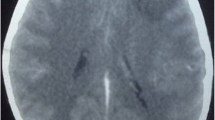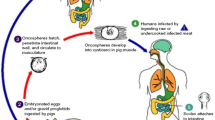Abstract
Background
Neurocysticercosis (NCC) is an infestation of the nervous system caused by encysted larvae of Taenia solium. NCC is an important acquired cause of epilepsy and other neurological manifestations especially in endemic areas. NCC in children has pleomorphic manifestations depending on the location, number, viability of the cysts, and host response. Even with advancing knowledge of the disease manifestations, many aspects related to diagnosis and treatment, particularly in children, still remain controversial and pose challenges to clinical practice. There is no gold standard test to diagnose NCC and the management recommendations are still emerging. This review provides an overview of diagnosis of NCC in children and its management with special focus on current challenges and future prospects.
Discussion
In developing countries, NCC is important not only because of its frequency but also because of high morbidity and mortality rates associated, especially in cases in which it progresses to increased intracranial pressure. Because of its pleomorphic presentation, NCC should be considered in the differential diagnosis of a number of neurological conditions. Treatment with cysticidal therapy leads to reduction in seizure frequency and a faster resolution of lesions.
Conclusions
We have summarized the current approaches to diagnosis and treatment of NCC, recent advances in understanding the biology of NCC, and how one can take advantage of these new insights to formulate the next generation of clinical trials.





Similar content being viewed by others
References
Atluri VSR, Gogulamudi VR, Singhi P, Khandelwal N, Parasa LS, Malla N (2014) Pediatric Neurocysticercosis: usefulness of antibody response in Cysticidal treatment follow-up. BioMed Res Int 2014:904046. https://doi.org/10.1155/2014/904046
Blanton R (2007) Cysticercosis. In: Kliegman RM, Jenson HB, Behrman RE, Stanton BF (eds) Nelson textbook of Paediatrics. Saunders Elsevier pp, Philadelphia, pp 1514–1516
Carpio A, Fleury A, Romo ML, Abraham R, Fandino J, Duran JC (2016) New diagnostic criteria for neurocysticercosis: reliability and validity. Ann Neurol 80:434–442
Colli BO, Carlotti CG Jr, Assirati JA Jr, Machado HR, Valença M, Amato MC (2002) Surgical treatment of cerebral cysticercosis: long-term results and prognostic factors. Neurosurg Focus 15(12):e3
Colli BO, Valença MM, Carlotti CG Jr, Machado HR, Assirati JA Jr (2002) Spinal cord cysticercosis: neurosurgical aspects. Neurosurg Focus 15(12):e9
de Souza A, Nalini A, Kovoor JM, Yeshraj G, Siddalingaiah HS, Thennarasu K (2011) Perilesional gliosis around solitary cerebral parenchymal cysticerci and long-term seizure outcome:a prospective study using serial magnetization transfer imaging. Epilepsia 52:1918–1927
Del Brutto OH (1994) Prognostic factors for seizure recurrence after withdrawal of antiepileptic drugs in patients with neurocysticercosis. Neurology 44:1706–1709
Del Brutto OH, Garcia HH (2012) Neurocysticercosis in non endemic countries: time for a reappraisal. Neuroepidemiology 39:145–146
Del Brutto OH, Nash TE, White AC Jr, Rajshekhar V, Wilkins PP, Singh G et al (2017) Revised diagnostic criteria for neurocysticercosis. J Neurol Sci 372:202–210
Devi R, Jain A, Hurkat P, Jain SK (2015) Dual drug delivery using lactic acid conjugated SLN for effective management of neurocysticercosis. Pharm Res 32:3137–3148
Escobar A (1983) The pathology of neurocysticercosis. In: Palacios E, Rodriguez-Carbajal J, Taveras JM (eds) Cysticercosis of the central nervous system. Charles C Thomas, Springfield, pp 27–54
García HH, Evans CA, Nash TE, Takayanagui OM, White AC Jr, Botero D, Rajshekhar V, Tsang VC, Schantz PM, Allan JC, Flisser A, Correa D, Sarti E, Friedland JS, Martinez SM, Gonzalez AE, Gilman RH, Del Brutto OH (2002) Current consensus guidelines for the treatment of neurocysticercosis. Clin Microbiol Rev 15:747–756
Garcia HH, Nash TE, Del Brutto OH (2014) Clinical symptoms, diagnosis, and treatment of neurocysticercosis. Lancet Neurol 13:1202–1215
Kimura-Hayama ET, Higuera JA, Corona-Cedillo R, Chávez-Macías L, Perochena A, Quiroz-Rojas LY, Rodríguez-Carbajal J, Criales JL (2010) Neurocysticercosis: radiologic-pathologic correlation. Radiographics 30:1705–1719
Lobato RD, Lamas E, Portillo JM, Roger R, Esparza J, Rivas JJ, Muñoz MJ (1981) Hydrocephalus in cerebral cysticercosis. Pathogenic and therapeutic considerations. J Neurosurg 55:786–793
Michelet L, Fleury A, Sciutto E, Kendjo E, Fragoso G, Paris L, Bouteille B (2011) Human neurocysticercosis: comparison of different diagnostic tests using cerebrospinal fluid. J Clin Microbiol 49:195–200
Ndimubanzi PC, Carabin H, Budke CM, Nguyen H, Qian YJ, Rainwater E, Dickey M, Reynolds S, Stoner JA (2010) A systematic review of the frequency of neurocyticercosis with a focus on people with epilepsy. PLoS Negl Trop Dis 4:e870
Odashima NS, Takayanagui OM, Figueiredo JF (2002) Enzyme linked immunosorbent assay (ELISA) for the detection of IgG, IgM, IgE and IgA against cysticercus cellulosae in cerebrospinal fluid of patients with neurocysticercosis. Arq Neuropsiquiatr 60:400–405
Panic G, Duthaler U, Speich B, Keiser J (2014) Repurposing drugs for the treatment and control of helminth infections. Int J Parasitol Drugs Drug Resist 4:185–200
Prabhakaran V, Rajshekhar V, Murrell D, Oommen A (2007) Conformation-sensitive immunoassays improve the serodiagnosis of solitary cysticercus granuloma in Indian patients. Trans R Soc Trop Med Hyg 101:570–577
Prabhakaran V, Drevets DA, Ramajayam G, Manoj JJ, Anderson MP, Oommen A et al (2017) Comparison of monocyte gene expression among patients with neurocysticercosis-associated epilepsy, idiopathic epilepsy and idiopathic headaches in India. PLoS NTD 11(6):e0005664
Raina SK, Razdan S, Pandita KK, Sharma R, Gupta VP (2012) Active epilepsy as indicator of neurocysticercosis in rural Northwest India. Epilepsy Res Treat 2012:802747
Rajshekhar V (2001) Rate of spontaneous resolution of a solitary cysticercus granuloma in patients with seizures. Neurology 57:2315–2317
Rajshekhar V (2010) Surgery for neurocysticercosis. A review. Int J Surg 8:100–104
Rajshekhar V, Chandy MJ (1997) Validation of diagnostic criteria for solitary cerebral cysticercus granuloma in patients presenting with seizures. Acta Neurol Scand 96:76–81
Rajshekhar V, Chandy MJ (2000) Incidence of solitary cysticercus granuloma. In: Rajshekhar V, Chandy MJ (eds) Solitary cysticercus granuloma: the disappearing lesion. Orient Longman Ltd, Chennai, pp 12–28
Rajshekhar V, Jeyaseelan L (2004) Seizure outcome in patients with a solitary cerebral cysticercus granuloma. Neurology 62:2236–2240
Rajshekhar V, Oommen A (1997) Serological studies using ELISA and EITB in patients with solitary cysticercus granuloma and seizures. Neurol Inf Epidemiol 2:177–180
Rajshekhar V, Wilson M, Schantz PM (1991) Cysticercus immunoblot assay in Indian patients with single small enhancing CT lesions. J Neurol Neurosurg Psychiatry 54:561–562
Rajshekhar V, Raghava MV, Prabhakaran V, Oommen A, Muliyil J (2006) Active epilepsy as an index of burden of neurocysticercosis in Vellore district, India. Neurology 67:2135–2139
Serpa JA, White AC Jr (2012) Neurocysticercosis in the United States. Pathog Glob Health 106:256–260
Singh G, Bawa J, Chinna D, Chaudhary A, Saggar K, Modi M, Sander JW (2012) Association between epilepsy and cysticercosis and toxocariasis: a population-based case- control study in a slum in India. Epilepsia 53:2203–2208
Singh A, Singh AK, Singh SK, Paliwal VK, Gupta RK, Prasad KN (2014) Association of ICAM-1 K469E polymorphism with neurocysticercosis. J Neuroimmunol 276:166–171
Singhi P, Saini AG (2016) Pediatric neurocysticercosis: current challenges and future prospects. Pediatric Health Med Ther 7:5–16
Singhi P, Singhi S (2004) Neurocysticercosis in children. J Child Neurol 19:482–492
Singhi P, Suthar R (2015) Neurocysticercosis. Indian J Pediatr 82:166–171
Tsang VC, Brand JA, Boyer AE (1989) An enzyme-linked immunoelectrotransfer blot assay and glycoprotein antigens for diagnosing human cysticercosis (Taenia solium). J Infect Dis 159:50–59
Verma A, Prasad KN, Gupta RK, Singh AK, Nyati KK, Rizwan A, Pandey CM, Paliwal VK (2010) Toll-like receptor 4 polymor- phism and its association with symptomatic neurocysticercosis. J Infect Dis 202:1219–1225
Yamasaki H, Allan JC, Sato MO, Nakao M, Sako Y, Nakaya K, Qiu D, Mamuti W, Craig PS, Ito A (2004) DNA differential diagnosis of taeniasis and cysticercosis by multiplex PCR. J Clin Microbiol 42:548–553
Zammarchi L, Strohmeyer M, Bartalesi F, Bruno E, Muñoz J, Buonfrate D, Nicoletti A, García HH, Pozio E, Bartoloni A, COHEMI Project Study Group (2013) Epidemiology and management of cysticercosis and Taenia solium taeniasis in Europe: systematic review 1990–2011. PLoS One 8:e69537
Author information
Authors and Affiliations
Corresponding author
Ethics declarations
Conflict of interest
There was no financial support nor industry affiliations involved in this work. None of the authors has any personal or institutional financial interest in drugs, materials, or devices.
Rights and permissions
About this article
Cite this article
de Oliveira, R.S., Viana, D.C., Colli, B.O. et al. Pediatric neurocysticercosis. Childs Nerv Syst 34, 1957–1965 (2018). https://doi.org/10.1007/s00381-018-3889-4
Received:
Accepted:
Published:
Issue Date:
DOI: https://doi.org/10.1007/s00381-018-3889-4




